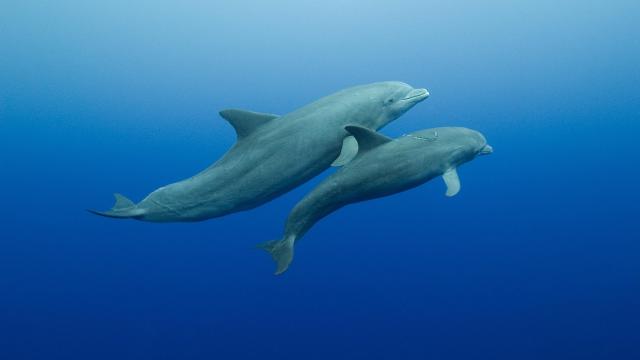It looks like baby talk isn’t just for humans. New research this week suggests that dolphin mothers also adopt a higher-pitched tone during certain forms of communication with their young.
Baby talk — also known as “mothese” — has been observed in just about every human culture and language. Though it’s most associated with mothers and their infants, even pet owners will practice a form of it with their cats or dogs. But according to the authors of this latest study, published Monday in the journal Proceedings of the National Academy of Sciences, there’s been little research looking at whether the phenomenon exists in non-human animals.
The new research was led by scientists at the Woods Hole Oceanographic Institution in Massachusetts. The team decided to study bottlenose dolphins in particular since they’re mammals known for forming long mother-child bonds, much like humans. They’re also capable of something called vocal production learning, or the ability to change the structure of their vocalisations in response to hearing those of others.
The researchers were able to study audio recordings made of the same 19 female wild bottlenose dolphins living in the waters near Sarasota Bay, Florida. The recordings spanned years of time and covered periods when the dolphins either were or weren’t spending time with calves dependent on them for survival. They focused on a specific type of dolphin communication, called a signature whistle. Dolphins are thought to use these whistles to identify themselves to other dolphins.
Compared to the time they spent alone or with other dolphins, the dolphin mothers noticeably increased the pitch and range of their signature whistles when around their calves, the researchers found.
“That was true for every one of the mums in the study, all 19 of them,” study co-author Peter Tyack, a biologist at the University of St. Andrews in Scotland, told the Associated Press.
The findings will have to be replicated by other researchers to truly confirm that baby talk is widely prevalent among bottlenose dolphins. More research will be also needed to understand the uses and potential purpose of baby talk in the species. In humans, for instance, it’s theorised that infants tend to prefer and listen better when they hear baby talk, so it might play a similar function with dolphin calves. The scientists also only focused on one particular form of dolphin communication in this study, the signature whistle, and it’s more than possible that baby talk is deployed in other situations.
Assuming this research holds up and is found elsewhere in the animal kingdom, though, baby talk might be an example of convergent evolution — an useful trait that arises independently in many not-so-closely related species for similar reasons.
